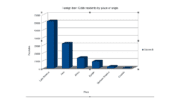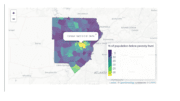[Editor’s note: A reader with expertise in real estate and development patterns in Cobb County emailed me that there were anomalies in the reported number of renter-occupied units in some of the census tracts in maps 3 and 4 below. He pointed to one census tract in East Cobb showing a high number of units where the community is single-family and one in Vinings where rental condos should have yielded a higher number of renter-occupied units.
I’m double-checking that all the numbers were pulled from census data correctly (I’m pretty confident from earlier spot-checks they were).
So my next step will be contacting the ACS folks and asking if there are any known limitations to the renter-occupied unit data.
One thing to make clear is that a renter-occupied unit can be a single-family home or apartment unit.]
This is another of the Courier’s Cobb by the Numbers examination of our growing county. This one looks at gross median rent and the number of rental units across the county at the census tract level. The data is from the U.S. Census Bureau’s recently-released 5-year American Community Survey.
To read about why we chose the census tract to examine different parts of the county, read the section after the maps.
Anyone who attends zoning hearings in the county knows that apartment buildings or rental units nearly always generate opposition and controversy. Older apartment buildings are also often in the news for substandard conditions and evictions.
We’re going to focus on two things at the census tract level and have provided interactive maps so that readers can explore the data: what is the gross median rent in different parts of the county?, and how many rental units are there in each census tract?
To help with that, we’ve provided two maps on each topic.
Clicking on any part of either map will give you the census tract number and the number associated with it (median gross rent or renter-occupied units) at that point on the map..
The first one of each pair has high color contrast and opacity, so you can get a good high-level overview of how rental rates and rental property are distributed around the county.
The second has lighter colors and more transparency so that you can pan around, zoom in, and find your street on the map and census tract. The darker map with higher opacity makes the street labels hard to read.
Maps showing median gross rent across the county
In the United States Census, “Median gross rent” refers to a specific statistic that measures the midpoint of the gross rent paid by renters in a particular area, such as a city, county, or region, during a specific time period (the maps below are from the 5-year ACS). The median is the value that separates the higher half from the lower half of a data set when all rent amounts are arranged in ascending order.
In plain language, many types of data are best viewed by looking at the median, because since half the data is above it and half below, it gives you a clearer idea of what’s typical for the data. In terms of gross median rent, if the median cost is $1500 for a census tract, and rental units are available, they’ll more than likely be pretty close to that number.
Gross rent includes both the monthly rent paid for a housing unit and any additional costs, such as utilities (water, electricity, gas, etc.) and fuels (oil, coal, etc.) that the tenant is responsible for. It represents the total housing expense for a renter.
So here are the maps for you to explore.
High-contrast map
Transparent map
This map should make it easier to find your street and census tract.
How are rental units distributed around the county?
These maps show how many occupied units are estimated by the U.S. Census Bureau to be in each census tract.
High-contrast map
High transparency map
Why the Courier uses census tracts to examine Cobb County by the numbers
There are two reasons we use census tracts rather than zip codes or other geographic units when we examine the characteristics of the county.
One is that the U.S. Census Bureau collects enormous amounts of data on the characteristics of census tracts, from family income, to housing cost, to commuting patterns. To drive that point home, there are over 31,000 variables in the Census Bureau’s American Community Survey. That’s a lot of information that drills down into very manageable geographic areas.
Another is that zip codes, which are often used to define areas (think Beverly Hills 90210) are nearly useless for most examinations of economic and demographic characteristics because they are too large. Think about the Mableton zip code 30126. It spans from Austell Road to the river, from south of Mableton Parkway to Smyrna. There is no way to generalize about economic and demographic characteristics, because it covers a large range of pockets of home values, incomes and racial and ethnic characteristics.
Census tracts vary in size due to the differences in density of different areas, but the U.S. Census published the following about their size in its glossary:
Census Tracts are small, relatively permanent statistical subdivisions of a county or statistically equivalent entity that can be updated by local participants prior to each decennial census as part of the Census Bureau’s Participant Statistical Areas Program (PSAP). The Census Bureau delineates census tracts in situations where no local participant responded or where state, local, or tribal governments declined to participate. The primary purpose of census tracts is to provide a stable set of geographic units for the presentation of statistical data.
Census tracts generally have a population size between 1,200 and 8,000 people, with an optimum size of 4,000 people. A census tract usually covers a contiguous area; however, the spatial size of census tracts varies widely depending on the density of settlement. Census tract boundaries are delineated with the intention of being maintained over a long time so that statistical comparisons can be made from census to census. Census tracts occasionally are split due to population growth or merged as a result of substantial population decline.





